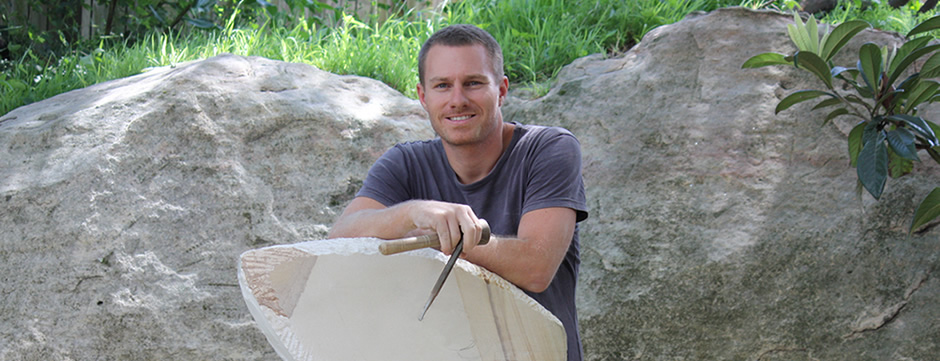About / Sydney Sculptor, Christophe Conder
Christophe’s early interest in sculpture began in Soapstone from the age of 12, and was introduced to the medium of sandstone by his French born mother and sculptor, who, herself, had been fortunate enough to receive invaluable tuition from her neighbour and well-known Sydney sculptor, the late Mitzi McColl, and although completing many clay, hebel stone and award winning sandstone works during his school years, Christophe’s talent remained dormant thereafter for many years through the life distractions of career, travel, and family.
Early in 2007, Christophe took a break from his successful marketing career as a brand developer to spend more time with his family. This gave Christophe the opportunity to unearth his hammer and chisels and revisit the blocks of sandstones that had been laying dormant awaiting his return in his back garden: he has never looked back…
Christophe’s work has been acquired by discerning collectors throughout the globe and has exhibited many of his works around the Australian public arena including the Parliament House Sydney, The Sydney Domain, The Royal Easter Show, The Australia Square Building, and Darling Park. He has also won an array of awards and recommendations.
Christophe chooses to work from natural Australian sandstone, handpicked from Gosford and Bundanoon quarries; he has a very strong connection with the stone and mentions
… “The quality of stones I hand pick from the quarries hold incredibly beautiful iron bands of grain which I attempt to unveil and celebrate in all my pieces…. Sandstone holds many aesthetically pleasing qualities that i admire. I love the raw physical nature of sandstone, it’s colour, it’s texture, touch, durability and the historic history and connection it holds with the earth ” …
Sandstone enables the smooth, simplified forms, subtle curves, flowing lines and rounded surfaces found in Christophe’s abstract works, and there are also many variations and combinations of textures waiting to be touched in his pieces. These textures include naturally weathered, frosted by chisels, rasped rough and polished smooth. Christophe has clues about the attributes of any given stone before he starts to sculpt it, but its full beauty and unique grains and characteristics are often not revealed until the sculpture nears completion.
Christophe’s sculpture not only offers the viewer an infinite number of vantage points, it also offers one of the most vital sensual characteristics – the sense of touch. This is equally as important as the visual experience. “
…”I carve sandstone as an invitation to touch. I want people to feel the smooth, warm strength and polished texture of the stone. I believe that the relevance of touching a stone is increasingly important in this visual age. I will never forget the day my son at the age of two, saw one of my abstract female works positioned in the backyard for the first time. He went straight up the torso with both hands and slid them down across her face and over her shoulders exploring the textures and spaces. It spoke volumes to me. If a 2 year old wanted to do this instinctively then i’d image all of us would like to do the same…”
Other than his most admired artists Brancusi, Henry More and Barbara Hepworth, Christophe draws his inspiration from his fascination with the female form, mother nature and his interactions with the natural landscapes he grew up with across Sydney’s foreshores and national parks.
A Brief History on Sydney Sandstone
Sandstone forms the bedrock for much of the Sydney region and its harbour. Built up to 200 metres thick in some areas it was formed during the Triassic period (about 220 million years ago). It was formed from the sands which came from Antarctica about 200 million years ago, carried by a vast river system. Over millions of years these sands were consolidated into sandstone.
Sandstone is tan/cream to yellow in colour. Its internal brown markings (called grain) were formed by iron-rich currents moving the sands across a river delta, which seeped through the Sandstone many years after the rock had been laid down. These grains are also known as ‘Liesegang Rings’ giving Sandstone the iconic and attractive patterning. (see image below)
Sandstone is a very hard rock that tends to break away in large blocks leaving the boulders and vertical cliffs that characterises the Sydney coastline. Well known for its durable quality, it is the reason many Aboriginal rock carvings and drawings in the area still exist. As a highly favoured building material, especially preferred during the city’s early years—from the late 1790s to the 1890s—its use, particularly in public buildings, gives the city its distinctive appearance. The stone is notable for its geological characteristics; its relationship to Sydney’s vegetation and topography; the history of the quarries that worked it; and the quality of the buildings and sculptures constructed from it.
References from http://en.wikipedia.org/wiki/



